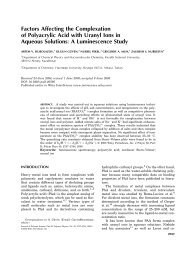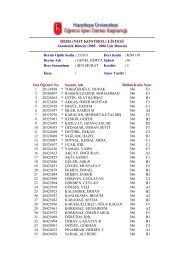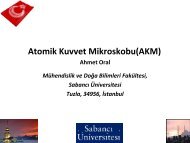Complexation behavior of antiestrogen.pdf
Complexation behavior of antiestrogen.pdf
Complexation behavior of antiestrogen.pdf
Create successful ePaper yourself
Turn your PDF publications into a flip-book with our unique Google optimized e-Paper software.
J Incl Phenom Macrocycl Chem<br />
Fig. 3 SEM<br />
photomicrographs <strong>of</strong> b-CD,<br />
b-CDC6, TMX and the<br />
co-lyophilizates<br />
TMX, cyclodextrin and the co-lyophilizate for TMX:b-<br />
CD and TMX:b-CDC6, respectively. Thermograms<br />
indicate the absence <strong>of</strong> free crystalline TMX due to the<br />
disappearance <strong>of</strong> typical TMX melting endotherm at<br />
149 °C. DSC thermogram <strong>of</strong> TMX was taken after<br />
lyophilization <strong>of</strong> the drug in order to avoid alterations in<br />
the crystalline structure to amorphous state during the<br />
lyophilization process. FTIR spectra <strong>of</strong> the co-lyophilizate<br />
also indicated the disappearance <strong>of</strong> typical bands <strong>of</strong><br />
tamoxifen citrate such as tertiary amine bands at 900–<br />
1100 cm –1 , C=C stretching peaks at 1600–1700 cm –1 and –<br />
COOH band at 3000 cm –1 . This indicates that the drug’s<br />
chemical properties are masked due to inclusion in CD<br />
cavity for both natural and amphiphilic cyclodextrins.<br />
Corresponding FTIR spectra are seen in Fig. 2a, b. H<br />
NMR spectra taken at 400 MHz indicate signal shifts<br />
in the internal protons <strong>of</strong> the cavity H-3 and H-5 with<br />
shifts for H-3 being more significant for b-CDC6 compared<br />
to b-CD. Chemical shifts in proton signals for b-CD<br />
complex and b-CDC6 complex <strong>of</strong> tamoxifen citrate,<br />
respectively are given in Tables 1 and 2. Finally,SEM<br />
photomicrographs given in Fig. 3a–e indicate that<br />
the crystalline structures <strong>of</strong> the co-lyophilizates are<br />
significantly different than the free drug and the<br />
cyclodextrins. This could be due to the co-lyophilization<br />
techniques that is used to prepare the complexes which is<br />
very similar to the spherical crystallization techniques<br />
used in the manufacturing <strong>of</strong> nanoparticles. Crystalline<br />
structures <strong>of</strong> the free drug and the cyclodextrins are<br />
changed after the co-lyophilization process with a completely<br />
new crystalline or amorphous structure for the<br />
complex [17].<br />
Anticancer efficacy <strong>of</strong> TMX:b-CDC6 was found to<br />
be significantly higher than the TMX:b-CD as shown in<br />
Fig. 4. This was attributed to the fact that b-CDC6<br />
possesses two hydrophobic zones that the drug may be<br />
density<br />
Optical<br />
1,4<br />
1,2<br />
1<br />
0,8<br />
0,6<br />
0,4<br />
0,2<br />
0<br />
incorporated within; the CD cavity and the long aliphatic<br />
chains [17]. b-CDC6 is aligned with 14 aliphatic<br />
chains <strong>of</strong> 6C length which provides an advantage for<br />
interaction with lipophilic molecules. Thus, it is believed<br />
that higher amount <strong>of</strong> TMX was believed to be<br />
entrapped in amphiphilic cyclodextrin; b-CDC6 when<br />
compared to natural cyclodextrin, b-CD leading to<br />
significantly higher anticancer efficacy against human<br />
breast carcinoma cell line MCF-7.<br />
Conclusion<br />
Control TMX:BCD TMX:BCDC6<br />
Tested Formulation (1/16 dilution)<br />
Fig. 4 Anticancer efficacy expressed by cell viability (OD) <strong>of</strong><br />
MCF-7 cells after administration <strong>of</strong> TMX:b-CD, TMX:b-CDC6<br />
and control (treated with PBS pH 7.4)<br />
Poorly-soluble <strong>antiestrogen</strong> drug tamoxifen used in the<br />
treatment <strong>of</strong> metastatic breast cancer can be complexed<br />
to both natural and amphiphilic b-cyclodextrins.<br />
<strong>Complexation</strong> to amphiphilic b-cyclodextrin seems to<br />
result in high anticancer efficacy for the drug. CD<br />
123








